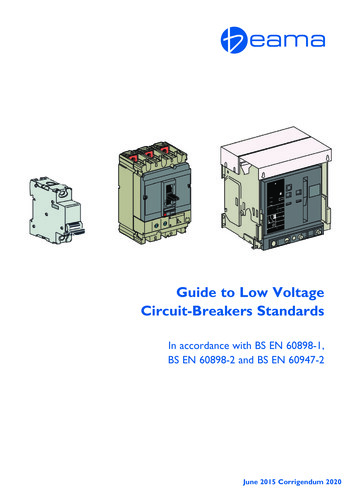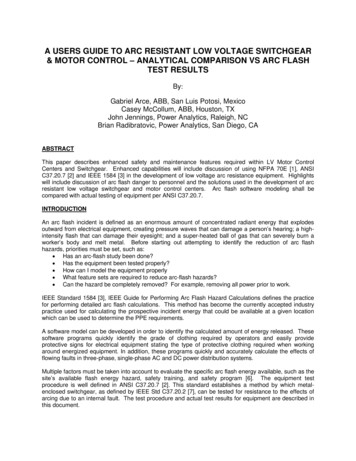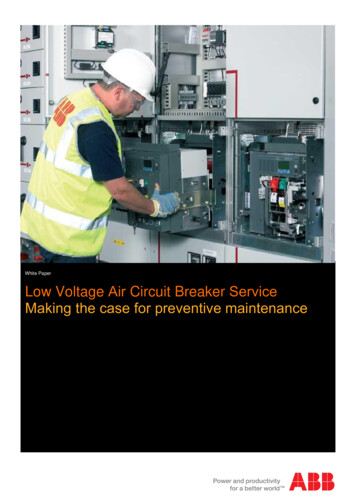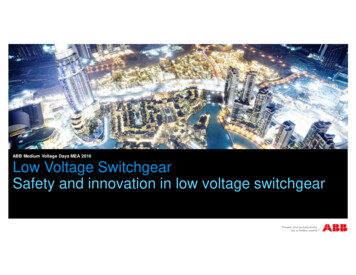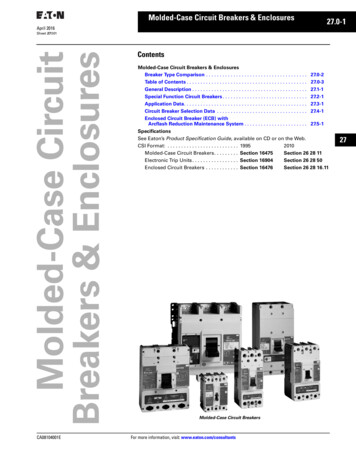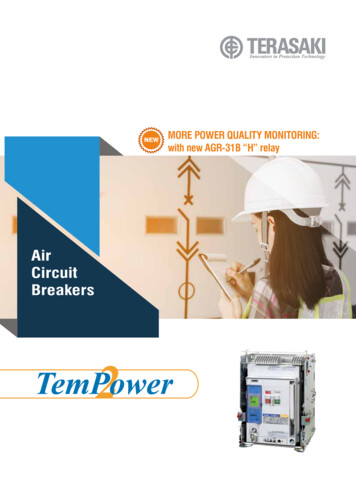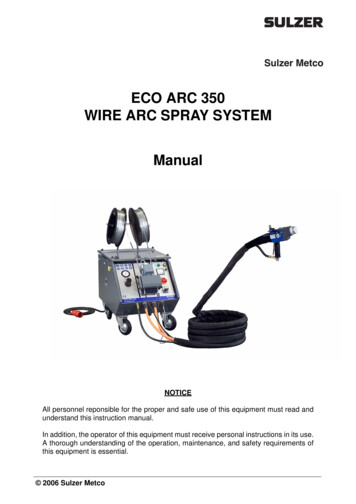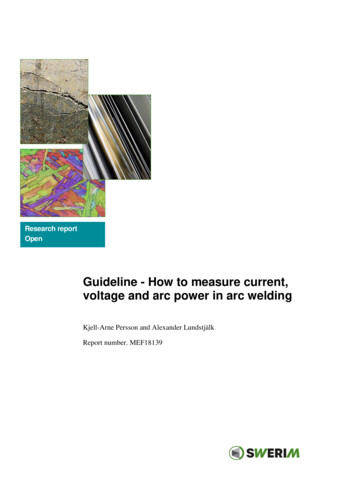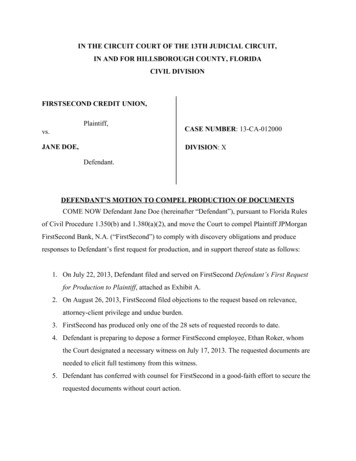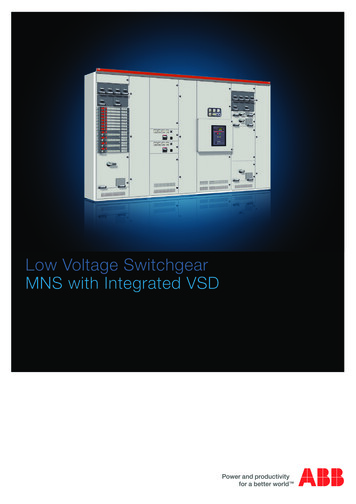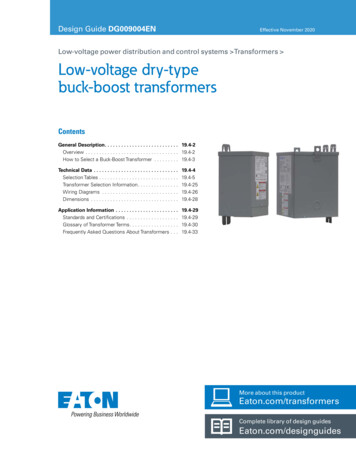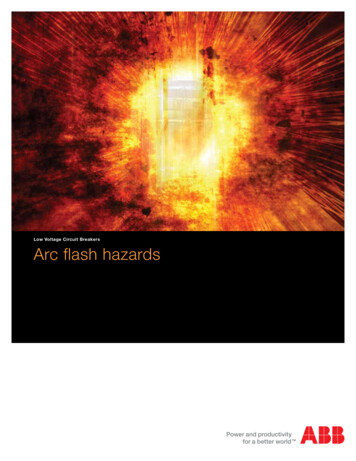
Transcription
Low Voltage Circuit BreakersArc flash hazards
IndexLow voltage selectivity with ABB circuit breakersIntroduction. 2Definitions, acronyms and terms used. 3Electrical arcs and their dangerous effects on people. 4Reference standards. 5Arc flash hazard analysis. 6Minimize arc flash effects. 8ABB solutions. 9Annex A: Arc flash hazard (mathematical approach). 12Low Voltage Products & SystemsABB Inc. 888-385-1221 www.abb.com/lowvoltage11SXU210204G0201
IntroductionScopeBasic Concepts:There are essential requirements for electrical safety. Bothdomestic and international standards refer to steps andprocedures to be taken for protection against hazards fromelectrical equipment. In particular, high temperatures andelectrical arcs or arc flash can cause catastrophic damage. This document illustrates the approach taken in theUnited States to safeguard against the hazards derived fromelectrical arcs and their effects on human beings. It alsosums up the recommendations of the US standards for allpersonnel working on live electrical equipment.What is an Arc Flash? According to NFPA 70E (the relevantstandard from the National Fire Protection Association), ArcFlash is a “dangerous condition associated with the releaseof energy caused by an electrical arc.” It is measured interms of arc flash incident energy E (AFIE), which is used todetermine the level of Personal Protective Equipment (PPE),and in terms of an arc flash protection boundary (FPB).Arc Flash Hazard is the term used to define the danger topeople working on live parts.The Arc Flash Hazard Analysis defines the procedureswhich limit the damage of electrical arcs on personnel and,by measuring the released energy, defines the risk areasand determines the relevant level of the personal protectiveequipment (PPE).An electrical arc occurs whenever there is a loss of insulation between two conductive objects at sufficient potential(voltage). Near high power electrical equipment, such astransformers, service entrance switchgear or generators,the short-circuit power available is high and consequentlyso is the energy associated with the electrical arc in case ofa fault.The energy released by the arc due to a fault creates arise in the temperature and pressure in the surroundingarea. This causes mechanical and thermal stress to nearbyequipment and creates the potential for serious injuries inthe vicinity.21SXU210204G0201Low Voltage Products & SystemsABB Inc. 888-385-1221 www.abb.com/lowvoltage
Definitions, acronyms and terms usedArc FlashDangerous condition associated with the release of energycaused by an electrical arc.Arc Flash HazardsDangerous conditions deriving from the release of energydue to a phase-to-phase or a phase-to-ground fault. Additionally, the arc flash analysis aimed at defining the procedures necessary to minimize the dangerous effects of thearc flash on personnel.NFPANational Fire Protection Association; a voluntary membership organization whose aims are to promote and improvefire protection and prevention.PPEPersonal Protective Equipment; safety devices or safeguards worn by personnel to protect against environmentalhazards. PPE includes helmets, safety goggles, hearingprotection, face shields, respirators, arm guards, smocks,gloves, and safety boots.OSHAOccupational Safety and Health Administration; US Department of Labor. OSHA develops and enforces federalstandards for occupational safety and health.IEEEInstitute of Electrical and Electronics Engineers. An American based global non-profit professional organization activein areas ranging from computers and telecommunicationsto biomedical engineering, electric power and consumerelectronics among others.NECNational Electrical Code. A set of regulations pertaining toelectrical installation and design in the interest of the protection of life and property for the United States. Publishedbiennially by the NFPA, (NFPA 70).Arc ratingMaximum resistance of a determined material to the incident energy.Flash protection boundaryThe distance from exposed conductive parts, within whicha person could receive a second degree burn in case of anarc faultLow Voltage Products & SystemsABB Inc. 888-385-1221 www.abb.com/lowvoltageArc faultShort-circuit current resulting from conductors at differentvoltages making less than solid contact. Results in a relatively high resistance connection compared to a bolted fault.Bolted faultShort-circuit current resulting from conductors at differentvoltages becoming solidly connected together.Arcing current IaCurrent flowing through the electric arc plasma, also calledarc fault current or arc current.Normalized incident energy EnThe amount of energy measured on a surface, at 24”(610mm) from the source, generated during an electrical arcevent of 0.2s.Incident energy EThe amount of energy measured on a surface, a certaindistance from the source, generated during an electrical arcevent.Curable burnA burn that will not cause irreversible tissue damage. Thisis a second degree burn where the skin temperature doesnot exceed 350 F (175 C) with a duration no longer than0.1 second and is curable in 7 to 10 days.Clearing timeThe total time between the beginning of the overcurrentand the final opening of the circuit at rated voltage by anovercurrent protective deviceLimited Approach BoundaryAn electrical shock protection boundary to be crossed byqualified personnel only (distance from live parts), not tobe crossed by unqualified personnel unless escorted by aqualified person.Restricted Approach BoundaryAn electrical shock protection boundary to be crossed byqualified personnel only which, due to its proximity to ashock hazard, requires the use of shock protection techniques and equipment when crossed.Prohibited Approach BoundaryA shock protection boundary to be crossed by qualifiedpersonnel only which, when crossed by a body part orobject, requires the same protection as if direct contact ismade with a live part.31SXU210204G0201
Electrical arcs and their dangerous effects on peopleThe arc formation in a cubicle can be described in 4phases:1. Compression phase: the volume of the air where thearc develops is overheated due to the release of energy.The remaining volume of air inside the cubicle heats upfrom convection and radiation. Initially there are differenttemperatures and pressures from one zone to another;2. Expansion phase: from the first instant of internalpressure increase, a hole is formed through which thesuperheated air begins to escape. The pressure reachesits maximum value and starts to decrease from therelease of hot air;3. Emission phase: due to continued contribution ofenergy by the arc, nearly all the superheated air is forcedout by an almost constant overpressure;4. Thermal phase: after the expulsion of the air, the temperature inside the switchgear nears that of the electrical arc. This final phase lasts until the arc is quenched,when all the metals and the insulating materials cominginto contact undergo erosion with production of gas,fumes and molten material.Should the electrical arc occur in an open configurationsome of the described phases might not be present or haveless effect; however, there will always be a pressure waveand a rise in temperature in the zones surrounding the arc.Most faults occur during switchgear maintenance or duringmanual operation of the equipment (eg: racking in/out ofwithdrawable equipment). Under these circumstances, notonly are personnel in front of the switchgear, and consequently likely to be engulfed by the electrical arc, but thefault is very often caused by the operations carried out(closing a circuit breaker under short-circuit, dropping atool on live bus bars, etc.).Being in the proximity of an electrical arc is extremely dangerous: Pressure: at a distance of 24” (61cm) from an electricalarc associated with a 22 kA arcing fault a person canbe subject to a force of 500lb (225kg); furthermore,the sudden pressure wave may cause rupture of theeardrums or permanent injuries; Temperatures of an arc can reach about 34,232 ºF(19,000 C; the surface of the Sun is 6,000 C) Sound: electrical arc sound levels can reach 160 db, (ajet engine at 100’ (30m) is 140 db).The electrical arc lasts until the opening of the overcurrentprotective device on the supply side of the electrical arc.The faults that may occur in electrical switchgear are primarily: phase-to-ground fault; phase-to-phase fault.A three-phase fault is less common, but it is necessary toremember that phase-to-ground and phase-to-phase faultsmay rapidly evolve into a three-phase fault.Both types of fault may be caused by accidental contact ofa person or a tool with live parts.The physical effects of an arc flash are: pressure wave in the environment where the arc isgenerated; heating of the materials coming into touch with the arcflash; potentially harmful light and sound.Personnel hazards due to the release of energy generatedby an arc event may include: burns; injuries due to ejection of materials; damage to hearing and to eye-sight; inhalation of toxic gasesBurnsThe high temperature levels of the gases produced by theelectrical arc and the expulsion of incandescent metal particles may result in severe burns.Flames can cause all types of burns, up to carbonization:the red-hot solid metal fragments can cause third degreeburns, superheated steam causes burns similar to hotliquids and the radiant heat generally causes less severeburns.Injuries due to ejected materialsThe ejection of metal particles or other loose items causedby the electric arc can result in severe injuries to the mostsensitive parts of the human body, like the eyes. The materials expelled due to the explosion produced by the arc maypenetrate the cornea. The extent of the lesions depends onthe characteristics and kinetic energy of these objects.Also, the eye area can sustain injuries to the mucosa, suchas the cornea or retina, because of the gases released bythe arc and the emission of ultraviolet and infrared rays.HearingAs already mentioned, the electric arc is a true explosion,whose sound may cause permanent hearing loss.Inhalation of toxic gasesThe fumes produced by burnt insulating materials andmolten or vaporized metals can be toxic. These fumes arecaused by incomplete burning and are formed by carbonparticles and by other solid substances suspended in the air.41SXU210204G0201Low Voltage Products & SystemsABB Inc. 888-385-1221 www.abb.com/lowvoltage
Reference standardsThe Standards dealing with prevention of arc flash effectsare: OSHA 29 Code of Federal Regulations (CFR) Part 1910Subpart S, NFPA 70-2008 National Electrical Code, NFPA 70E-2009 Standard for Electrical Safety Requirements for Employee Workplaces, IEEE Standard 1584-2008 Guide for Performing ArcFlash Hazard Calculations.The Occupational Safety and Health Administration (OSHA)regulates workers’ safety and health and has asked theNational Fire Protection Association (NFPA) to prepare astandard to safeguard employees working in the proximityof energized electrical equipment (NFPA 70E). OSHA is notobliged to comply with NFPA 70E, but does recognize it asa standard for industrial applications.OSHA 29 CFR requires that employers assess the arc flashhazard (CFR 1910.132). Should this hazard be present orlikely in determined areas, the standard itself requires theuse of suitable personal protective equipment (clothing andtools), which personnel shall wear within certain boundaries.If the requirements of NFPA 70E standard are applied, compliance with OSHA 29 CFR is guaranteed.The NEC (NFPA 70) concerns electrical installations andpersonnel health and safety in general, whereas NFPA 70Eis a document that is specifically for people working onelectrical devices.These standards require:The standards give the following guidelines: defining a safety program with clear responsibilities; procedures for arc flash hazard assessment; defining appropriate personal protective equipment(PPE) to be provided for the employees; training program for the employees regarding arc flashhazards; choosing suitable tools for a safe workplace; labeling equipment; labels shall be placed on theequipment by the plant owner and not by the manufacturer. The labels shall indicate the minimum protectivedistance, the energy level which can be released andrequired personal protective equipment (PPE).OSHA Standards require circuits to be de-energized priorto work on them unless de-energizing introduces additionalhazards or is unfeasible. Some examples include de-energizing emergency lighting, which might increase health andsafety hazards, or the performance of a particular test thatrequires the equipment be energized.Therefore if personnel worked on a completely de-energizedswitchboard and no operations were performed manually,no arc flash hazard would be present.Of course, this can rarely be achieved, so a detailed assessment of the incident energy is required. Based on this analysis, the appropriate personnel protective equipment can beprovided and the limited approach boundaries defined. to assess whether there are arc flash hazards (if theelectrical equipment was de-energized, for example,the hazard would not be present); to calculate the energy released by the arc, if present; to determine the flash protection boundary; to provide appropriate personal protective equipmen
IEEE Standard 1584-2008 Guide for Performing Arc Flash Hazard Calculations. The Occupational Safety and Health Administration (OSHA) regulates workers’ safety and health and has asked the National Fire Protection Association (NFPA) to prepare a standard to safeguard employees working in the proximity of energized electrical equipment .
